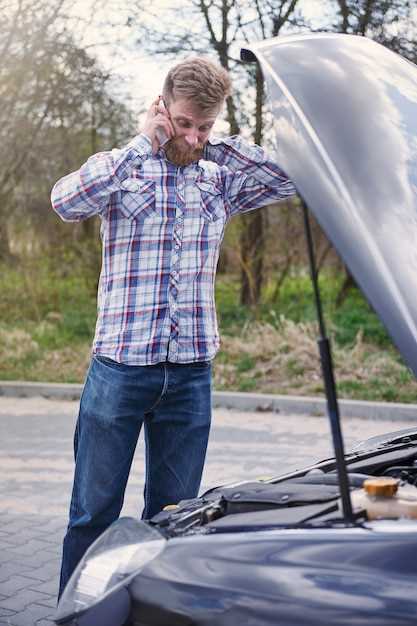
Experiencing a breakdown on the highway can be a stressful and daunting situation for any driver. Understanding the appropriate steps to take can make all the difference in ensuring your safety and minimizing the hassle involved. Being prepared for such emergencies is not only crucial for your well-being but also for the safety of other road users.
When your vehicle suddenly becomes inoperable, the first instinct might be panic. However, remaining calm and focused is essential. One of the first actions you should take is to move your car safely off the road, if possible. Utilizing your hazard lights is critical in alerting other drivers to your presence, making your vehicle more visible as you manage the circumstances of your breakdown.
Additionally, you should communicate your situation effectively. Whether you call for roadside assistance or a friend, being clear about your location and the nature of the problem will expedite help. Understanding your surroundings, such as nearby landmarks or mile markers, can significantly aid in this process. Preparation and knowledge can turn a potentially dangerous situation into a manageable one.
Assessing Your Situation and Vehicle Safety

When a breakdown occurs on the highway, the first step is to assess your situation. Pull over to the side of the road as safely as possible, ideally onto the shoulder or in a designated emergency stopping area. Ensure that your vehicle is visible to other drivers to minimize the risk of accidents.
Next, evaluate the condition of your vehicle. Check for any signs of smoke, unusual odors, or fluid leaks that may indicate the reason for the breakdown. If safe to do so, attempt to restart the engine. However, if there is any sign of danger, such as a fire or strange noises, do not engage further with the vehicle.
Prioritize your safety and the safety of your passengers. Exit the vehicle from the passenger side, away from oncoming traffic, and move to a safe location, such as behind a guardrail or far enough from the road. Always keep a safe distance to avoid potential hazards.
If you have roadside assistance, use your mobile phone to contact them. Provide clear information regarding your location and the nature of the breakdown. If you do not have a phone or cannot call for help, signal for assistance using an emergency flag or hazard lights.
While waiting for help, stay alert and vigilant about your surroundings. Being aware of oncoming traffic can help you assess any potential dangers that may arise while you wait. Ensuring your safety should be your top priority during a vehicle breakdown on the highway.
Communicating Your Breakdown to Authorities and Services
When your car breaks down on the highway, effective communication with authorities and roadside assistance services is crucial for your safety. First, stay calm and assess your situation. Ensure you are in a secure location away from traffic, if possible, before making any calls.
Begin by informing any nearby motorists, if you can do so safely, that you need assistance. Next, use your mobile phone to contact roadside assistance or emergency services. Clearly state your location, providing mile markers or exit numbers for pinpoint accuracy. This information helps responders reach you quickly.
When speaking with dispatchers, describe the nature of your breakdown succinctly. Mention whether you have encountered a flat tire, engine failure, or any other issue. This allows them to send the appropriate help, such as a tow truck or a mechanic equipped for specific repairs.
If you have a roadside assistance plan through your insurance or an auto club, provide your membership details to expedite service. Always keep your phone charged while traveling and consider using a car charger to maintain battery life during emergencies.
In addition to directly communicating with assistance services, it may be prudent to contact local law enforcement if your vehicle is obstructing traffic, to ensure proper safety measures are implemented.
By effectively relaying your situation and adhering to safety protocols, you not only facilitate faster assistance but also contribute to the overall safety of the roadway while you wait for help to arrive.
Handling Emergency Repairs and Getting Back on the Road

When experiencing a breakdown on the highway, safety should be your top priority. Before attempting any repairs, ensure that your vehicle is on a stable and flat surface, away from traffic. Turn on your hazard lights to alert other drivers of your presence. If possible, move your car to a designated emergency lane to prevent further danger.
Once you have secured a safe environment, assess the nature of the breakdown. A flat tire, overheated engine, or dead battery are common issues that may require immediate attention. For a flat tire, find your spare and necessary tools. If you’re unsure about the repair process, refer to the owner’s manual for guidance. In the case of an overheated engine, it’s best to wait for the engine to cool down before checking fluid levels or opening the hood, as hot components can pose a risk.
If you have the necessary skills and tools, carry out basic repairs. Replacing a tire or jump-starting a battery can often be done without professional assistance. However, if the situation seems too complex or dangerous, do not hesitate to call for roadside assistance. Many insurance policies can provide coverage for such services, assisting you in getting back on the road safely.
While attempting any repairs, be aware of your surroundings. Other drivers may not see your vehicle immediately, so maintaining a vigilant position is crucial. If you’re unable to resolve the issue quickly, consider waiting in your vehicle. It offers added protection and reduces your exposure to road hazards.
After making the necessary repairs, conduct a quick safety check to ensure that everything is in working order. Restart your vehicle, check for any unusual sounds, and confirm that all lights are functional before merging back into traffic. Taking these steps helps ensure a safer return to your journey.



